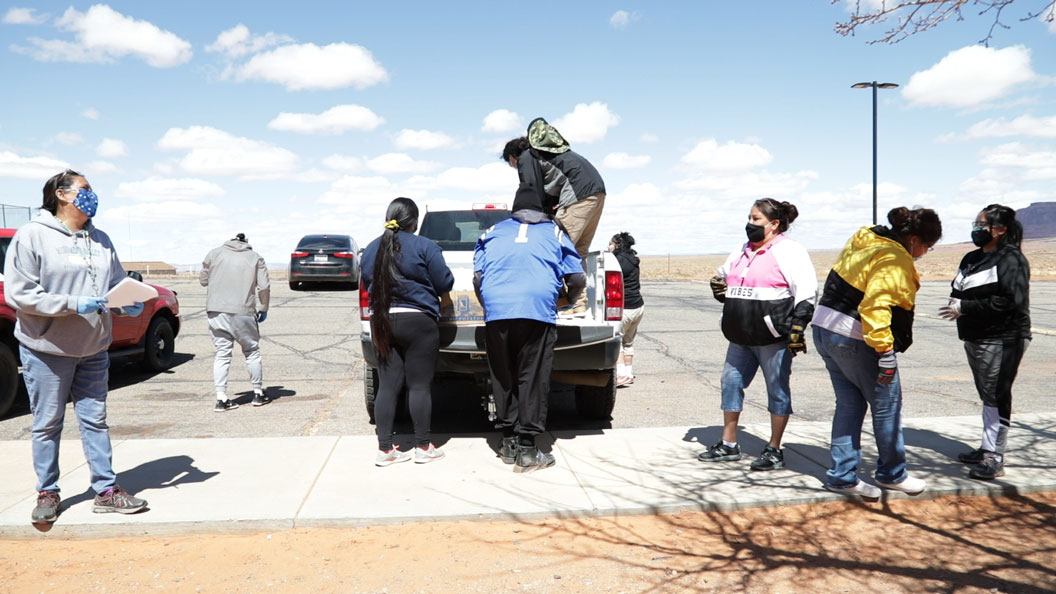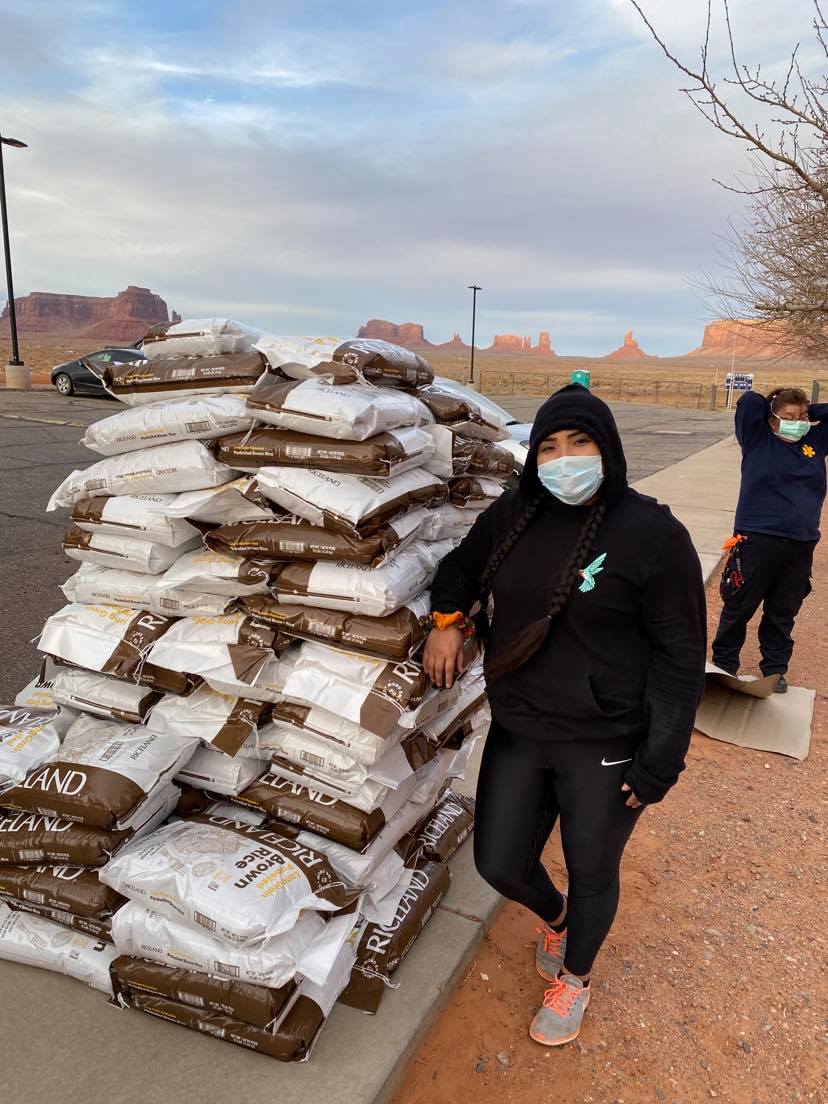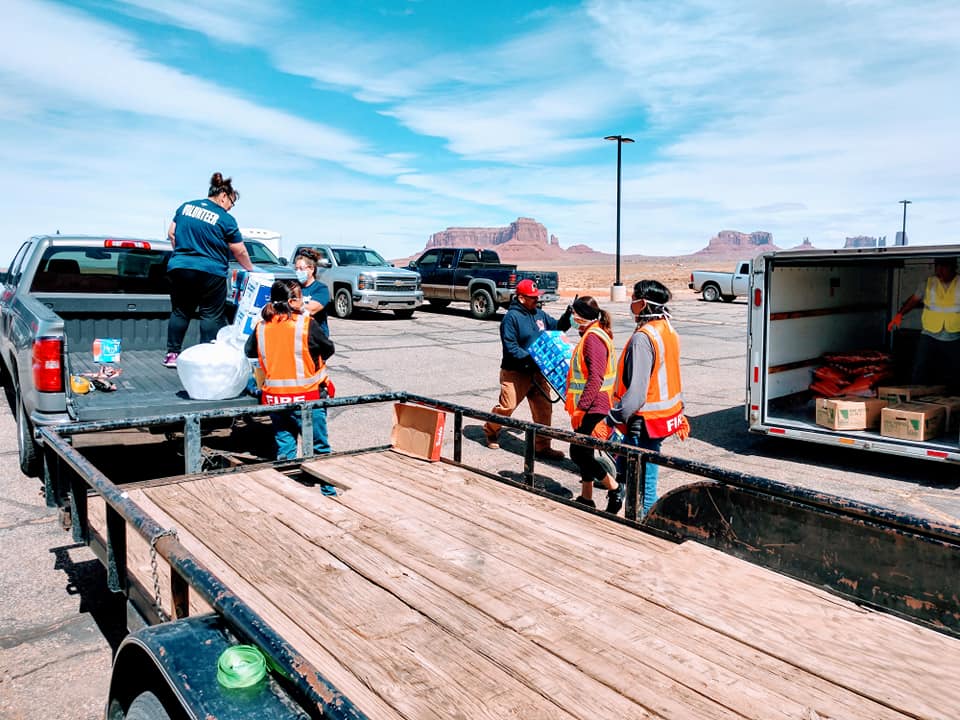Filed under: Action, Community Organizing, Disaster, Indigenous, Southwest

Report on growing mutual aid initiatives and the escalating health crisis brought on by the COVID-19 pandemic, facing Diné (Navajo) and Hopi communities in the so-called Southwest. Originally posted to Navajo Hopi Solidarity.
TSIIZIZII, DINÉTAH (LEUPP, NAVAJO NATION/ARIZONA) — In response to the escalating health crisis facing Diné (Navajo) and Hopi communities in Northern Arizona, Southern Utah, and New Mexico, the Navajo & Hopi Families COVID-19 Relief Fund has mobilized volunteer emergency food and water distribution throughout the region.
“It is so amazing to see our communities come together and respond proactively to the threat of coronavirus and COVID-19 on the Navajo and Hopi reservations.” said Ethel Branch, former Navajo Nation Attorney General and founder of the Relief Fund. “I thought this would make just a small impact, but the great love and care that the public has for our communities, and their sense of justice to correct the inequities that exist in Indigenous communities has morphed this effort into a movement.”
On March 15, 2020, Ethel organized a GoFundMe campaign to provide relief for Diné and Hopi families impacted by the COVID-19 virus. Within 22 days, the campaign has raised more than $400,000. “In just a few weeks we have managed to build a massive collaborative effort bringing together Diné and Hopi professionals, grassroots organizers and concerned community members to build the social net our communities have always deserved but have been denied because of treaty violations and on-going systemic injustices that make our communities extremely vulnerable to this pandemic” said Janene Yazzie, team lead in New Mexico for the Navajo-Hopi COVID-19 Relief Fund, “We have the expertise to build the solutions most meaningful for our people.”
The GoFundMe campaign’s mission is to “help the elderly (especially those raising their grandchildren), the immunocompromised and mobility impaired, single parents, and struggling families by helping them buy groceries, water, health supplies, and necessary items so they (and their vulnerable communities) can be protected from exposure to the virus by engaging volunteers to make these purchases and deliver them to a safe transfer location for those in need. We are also helping to stop the spread of COVID-19 on these reservations by engaging volunteers to sew masks for medical workers and first responders on Navajo and Hopi.” Since the campaign launched, the Relief Fund has received more than 4,500 requests for support and mobilized numerous volunteers to provide direct relief to over 850 families in over 21 communities, including Chilchinbeto, Hard Rock, Forest Lake, Kayenta, the Village of Bacavi, the Village of Oraibi, Oljato, Monument Valley, Tuba City, the Village of Upper Moencopi, the Village of Lower Moencopi, Dilcon, and Fort Defiance.
“Volunteers with the Navajo Hopi Covid 19 Relief effort are doing a great job responding to the crisis with resources raised from everyday people,” states Lillian Hill, Hopi Indigenous Food Advocate and Community Organizer, “Our Native American communities face unique and substantial disparities that put our communities at extra risk. I’m humbled to assist as a volunteer in this effort as a way to offer mutual aid to my community.”
COVID-19 CRISIS IN THE SOUTHWEST
Confirmed COVID-19 cases on the Navajo Nation are already growing at an exponential rate, nearly doubling by the day. As of April 7th there are currently 425 cases of COVID-19 and 17 confirmed deaths on the Navajo Nation, which has an on-reservation population of more than 180,000. During a town hall streamed on Facebook Navajo Nation president Johnathan Nez stated, “We feel that the United States government once again has ignored or even left out the first residents, the first people, the first citizens of this country: Indigenous people.” The Navajo Nation has projected that cases will peak by mid-May.
The Navajo Nation has been very proactive in responding to COVID-19. On March 11th, two days before President Trump, the Navajo Nation declared a state of Emergency as a proactive measure. On March 17th, the first case of COVID-19 was confirmed on the reservation. On the 18th the Nation closed itself to visitors. On March 20, the Nation issued a shelter-in-place order for everyone living on the reservation and imposed a curfew 10 days later. On March 23rd, the Hopi Tribe halted all tourism through its lands and reported its first known case on March 26th.
A CRITICAL NEED
Due to a host of systemic issues, tribal communities such as Navajo and Hopi are critically at risk during the COVID-19 pandemic. The CDC warns that older adults and those with underlying health conditions, such as diabetes and heart disease, are more likely to be severely impacted by COVID-19. These tribal communities have high numbers of elderly, diabetic, asthmatic, and cancer-afflicted individuals, putting them at a substantially elevated risk of requiring hospitalization for COVID-19. The Navajo Nation has 12 Indian Health Service facilities with a total of 170 hospital beds, 13 ICU beds, 52 isolation rooms, and 28 ventilators. Given the circumstances, the few medical facilities and resources on the Nation are likely to be severely overwhelmed in a short amount of time. As such, it is essential for the on-reservation community to stay at home to slow the spread of the virus.
Orders to “shelter in place” and remain at home, however, are exacerbating systematic social issues and placing additional strain on already under-resourced communities. The Navajo Nation and Hopi Reservation are extreme food deserts with only 16 grocery stores and small food markets that serve nearly 200,000 people.
A third of the people living on the Navajo Nation do not have electricity in their homes. Another third of the Nation’s residents do not have running water in their homes. Three of the twelve Hopi Villages largely do not have running water or electricity. Economic opportunities on these reservations are scarce. Thirty-eight percent of Navajo community members live in poverty and the Navajo Nation has approximately 50 percent unemployment. Hopi has about 60 percent unemployment.
A MESSAGE OF HOPE
“I know these are difficult times. But let’s remember we are never alone,” said Cassandra Begay, Communications Lead with the Navajo & Hopi Families COVID-19 Relief Fund, “Let’s remember the important relationships we have that are always with us: the relationship below our feet. The relationship with our heart. The relationship between our breath and our Mother Earth’s breath. And finally remember, this is an opportunity to be grateful for many things.”
Vanessa Tullie, the team’s Buyer and Volunteer Coordinator, noted that, “As this virus continues to spread across our Navajo and Hopi communities, compassion and care from volunteers will help relieve some of the disparities we are facing. We are strong, resilient, and powerful and so long as we work together and stay safe, we will make it through this pandemic.”
Please visit our website to donate and for additional resources including volunteer & support request forms: www.navajohopisolidarity.org.







